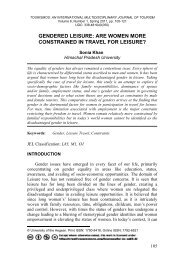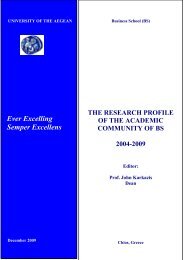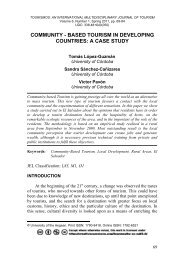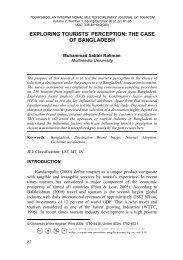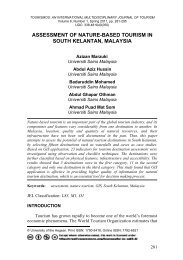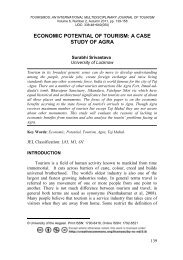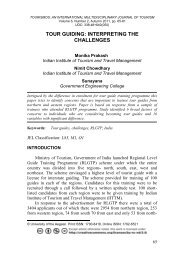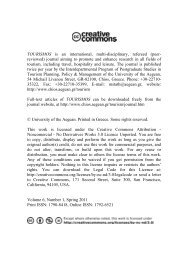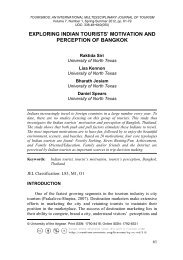is 'malaysia truly asia'? forecasting tourism demand from asean ...
is 'malaysia truly asia'? forecasting tourism demand from asean ...
is 'malaysia truly asia'? forecasting tourism demand from asean ...
You also want an ePaper? Increase the reach of your titles
YUMPU automatically turns print PDFs into web optimized ePapers that Google loves.
Loganathan Nanthakumar, Thirunaukarasu Subramaniam & Mori Kogidmodels suggest that Macau will face increasing tour<strong>is</strong>m <strong>demand</strong> byresidents <strong>from</strong> mainland China. The ECM model had also been used tomeasure tour<strong>is</strong>m <strong>forecasting</strong> but in the recent past, ECM model had beenmodified into vector error correction model (VECM) which can test andimpose weak exogeneity restrictions. Bonham, Gangnes and Zhau (2008)used VECM technique to identify reasonable long-run equilibriumrelationship and took into account Diebold-Mariano tests to demonstratesat<strong>is</strong>factory <strong>forecasting</strong> performance for Hawaii. Beyond the <strong>forecasting</strong>approach used in terms of tour<strong>is</strong>m <strong>demand</strong>, Akal (2010) investigated theeconomic implications of international tour<strong>is</strong>m on Turk<strong>is</strong>h economy. Theincreasing flows of international tour<strong>is</strong>t according to the author will havemany economic implications. In Turkey for instance, the dynamic flowsof international tour<strong>is</strong>ts have increased accommodation facilities; createnew employment in the tour<strong>is</strong>m related industry; increased foreign directinvestment in tour<strong>is</strong>m related industry; and foreign currency has becomemajor source of Turk<strong>is</strong>h economy.The main purpose of th<strong>is</strong> study <strong>is</strong> to provide a much morecomprehensive examination on tour<strong>is</strong>m <strong>forecasting</strong> using seasonalARIMA modelling. However, ex<strong>is</strong>ting literature on <strong>forecasting</strong>international tour<strong>is</strong>m <strong>demand</strong> for Malaysia so far had not adoptedseasonal auto-regressive integrated moving average (SARIMA)modelling. Therefore, th<strong>is</strong> paper intends to fill th<strong>is</strong> gap.DATA AND MODEL SPECIFICATIONData for th<strong>is</strong> study was collected <strong>from</strong> Malaysia tour<strong>is</strong>m arrivalsdataset provided by the Min<strong>is</strong>try of Tour<strong>is</strong>m Malaysia. The time-seriesdata used in th<strong>is</strong> study <strong>is</strong> quarterly data and it covers a period <strong>from</strong>1995:Q1 to 2009:Q4. Th<strong>is</strong> study focuses on the <strong>demand</strong> for tour<strong>is</strong>m inMalaysia <strong>from</strong> ASEAN countries and forecast 4 quarters ahead, which <strong>is</strong>2010:Q1 to 2010:Q4. In th<strong>is</strong> study, we used seasonal ARIMA models toforecast one-period ahead of the series by applying Box-Jenkinsapproach. An ARIMA model <strong>is</strong> a generalization of an ARMA model.These models are fitted to time-series data either to better understand thedata or to predict future points in the series (Chu, 2008a). The model <strong>is</strong>generally referred to as an ARIMA(p,d,q) 4 model where p,d and q areintegers greater than or equal to zero and refers to the order of theautoregressive, integrated and moving average aspects. In th<strong>is</strong> study weapplied Augmented Dickey-Fuller (ADF) and Phillip-Perron (PP)stationary tests to identify the level d in time series of international tour<strong>is</strong>t372



